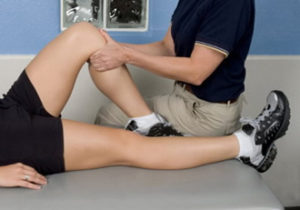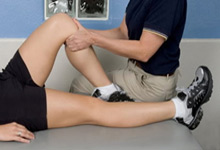 Physical therapy has long been heralded for its ability to help people with musculoskeletal and sports injuries. But in reality, more than 93,000 physical therapists (PTs) in America work in conjunction with other medical teams to help treat neurological, movement, and genetic disorders as well as more common issues like headaches and dizziness.
Physical therapy has long been heralded for its ability to help people with musculoskeletal and sports injuries. But in reality, more than 93,000 physical therapists (PTs) in America work in conjunction with other medical teams to help treat neurological, movement, and genetic disorders as well as more common issues like headaches and dizziness.
1. PARKINSON’S DISEASE
Boxing legend Muhammad Ali (diagnosed in 1984) and actor Michael J. Fox (diagnosed with young-onset Parkinson’s in 1991) might be the most visible Parkinson’s patients, but nearly 1 million Americans suffer from the chronic and progressive movement disorder. Treating the cardinal motor and non-motor symptoms involves cueing (a training exercise that helps reduce shuffling and freezing while walking) to help with walking and balance issues [PDF], resistance strength training to offset shrinking muscles, and strategies to help minimize tremors. “Physical therapists also play a vital role in exercise prescription to potentially assist with slowing down the disease progression,” Dr. Elizabeth Ulanowski, a Neurological Clinical Specialist who focuses on movement disorders, tells mental_floss.
2. HUNTINGTON’S DISEASE
A genetic disorder that breaks down nerve cells in the brain, the Huntington’s Disease Society of America has described symptoms of the disease as “having ALS, Parkinson’s, and Alzheimer’s—simultaneously.” It causes involuntary movements and spasms, impaired judgment, unsteady gait, slurred speech, and rapid weight loss. One of the main focuses of treatment is improving core strength and stability to control chorea (abnormal involuntary movement). Physical therapy can also help with functional mobility, everyday tasks like getting in and out of bed, cognition improvement with dual tasking, and balance.
“A fall on the stairs is one of the first balance symptoms of the disease,” Ulanowski says. “Therefore, a physical therapist should be involved early and consulted with to ensure safety and train the patient in balance strategies.”
3. PELVIC PAIN AND SEXUAL DYSFUNCTION
Many issues associated with pelvic floor dysfunction and pain can be treated with targeted exercises and stretches. In women, pelvic floor dysfunction often starts with pregnancy and childbirth, but men often struggle with the condition as well. PTs also work with patients on correcting posture and teaching better ways of lifting and carrying children and getting up from a sitting position properly to alleviate pain. Hot or cold packs, massages, manipulations, and electrical stimulation are often used in treatment as well.
Incontinence, pelvic pain, and sexual dysfunctions in men and women can also be remedied by physical therapists [PDF]. Treatment can involve myofascial release (or, applied sustained pressure on your body’s fascia, the tissue that connects and separates your muscles, organs, and other soft structures), nerve and tissue mobilization, manual therapy, piroformis stretches, electrical stimulation, and yoga exercises, like the happy baby pose.
4. CEREBRAL PALSY
A blanket term that refers to loss of motor function in children, cerebral palsy is caused by brain damage, infection, or abnormal development of the brain before, during, or immediately following birth. PTs work with patients during three different developmental stages and shift treatment accordingly. Before age 4, the focus is on play activities to improve strength and movement; when a child matures to school-age, the treatment involves care in walking, transfers, and school-based activities, as well as maintaining exercise programs and participating in adaptive sports like swimming, bowling, or cycling; upon reaching adulthood, PTs help develop programs to maintain strength, minimize joint problems, and manage pain.
5. CANCER
Along with the surgeries, chemotherapy, radiation, and medication, cancer patients can seek relief from physical therapists in acute, outpatient, and skilled nursing settings. PTs can help patients suffering from lung, bone, colon, brain, and other cancers with handling the side effect of their treatments, including reducing fatigue and regaining or maintaining strength. The American College of Sports Medicine’s recommendations for cancer survivors includes aerobic, flexibility, and resistance exercise at least 150 minutes per week.
“Management of the consequences of the cancer and its treatment have become quality of life issues,” says physical therapist Mary Fisher, a cancer and lymphedema specialist and assistant professor at the University of Dayton. “Physical therapists are essential in preventing, identifying, and treating impairments that are a result of the cancer experience in order to help individuals reach their fullest potential for activities and participation in life.”
6. LYMPHEDEMA
The lymphatic system gathers excess fluids (lymph) and moves them through the body and the bloodstream. When swelling (edema) occurs, often following infection, cancer, or radiation (which causes scar tissue), therapists use compression garments or complete decongestive therapy to reduce the swelling and slow future fluid buildup.
7. MULTIPLE SCLEROSIS
A disabling central nervous system disorder, multiple sclerosis (MS) has no known cause, is most often diagnosed between the ages of 20 and 50, and strikes women more than twice as often as men. Because of muscle weakening, spasticity, and numbness, therapists work with patients on gait training, mobility, and balance as well as help with assistive devices like canes and scooters.
8. DIZZINESS
Lightheadedness, vertigo, and general unsteadiness is a frequent complaint of people over the age of 65 and can lead to dangerous falls. Dizziness and balance disorders can be alleviated by working on balance exercises and vestibular rehabilitation, a type of therapy that teaches patients to compensate for their balance issues by improving vision and body sense.
9. MUSCULAR DYSTROPHY
More than 30 genetic diseases comprise the neuromuscular condition commonly referred to as muscular dystrophy. To combat the progressive weakening and degenerative skeletal problems associated with the various disorders, therapists can prescribe mobility aids like braces and splints, and work with children and adults with exercises as simple as walking up stairs and kicking a ball or using standing frames for support.
10. BURNS
Severe burns and wounds are tended to immediately in acute care settings, where PTs, in collaboration with a health care team, initiate treatments and exercises to manage scarring and stave off the loss of range of motion. Electrical stimulation, compression garments, and continuous passive-motion machines help mobilize joints and slow contracting and stiffening. Splinting can also help eliminate unwanted scar tissue.
11. OSTEOARTHRITIS
Osteoarthritis, the most common joint disease that causes disability, affects approximately 27 million people in the United States. Inflammation and degeneration of the bones in the joint (most often of the knee, hips, hands, or feet) can lead to pain, stiffness, and swelling. Manual therapy exercises, range-of-motion assessments, and strengthening of the surrounding muscles (quadriceps and hamstrings for osteoarthritis in the knee, for instance) can reduce pain and increase functionality.
12. CARPAL TUNNEL SYNDROME
Because humans weren’t designed to sit at a computer all day, about 1 in 20 Americans develop repetitive stress injuries. Simply changing your posture can help, as can various stretches, splints, and exercises of the muscles in the hands, forearms, wrists, and back.
13. COPD
While you might not think that physical therapists would be able to help with a respiratory issue, Chronic Obstructive Pulmonary Disease (COPD), most commonly chronic bronchitis or emphysema, can lead to loss of muscular strength and balance issues. And don’t forget, the lungs themselves can be strengthened with exercise. PTs, as part of a pulmonary rehabilitation team, work on strengthening the inspiratory muscles with pursed lip and diaphragmatic breathing to decrease shortness of breath and make each breath more efficient.
14. DIABETES
“Exercise is a cornerstone for prevention and management of diabetes,” says Dr. Gina Pariser, a physical therapy professor at Bellarmine University who directs the Active Steps for Diabetes community campus program. PTs also help with complications in the lower extremities to allow for continued daily activities and exercise.
“Exercise guidelines for controlling blood sugar include 30 minutes of moderate intensity aerobic exercise five times per week, and to avoid skipping exercise more than two days in a row,” Pariser says. “In addition to aerobic exercise, weight training is recommended to improve insulin sensitivity and to prevent mobility impairments. Tai chi has been shown to improve balance in patients with diabetes and peripheral neuropathy.”
15. CHRONIC FATIGUE SYNDROME
Chronic Fatigue Syndrome (CFS) is not a psychological illness, as many physicians once thought, but a complex disorder with a range of symptoms that cause debilitating and unceasing tiredness that doesn’t improve with rest. Doctors and physical therapists can work with patients on cardiopulmonary exercise testing, questionnaires, and screening to determine a course of action to treat each patient’s individual symptoms. Treatment usually involves short-term endurance training and balancing daily tasks with rest.
16. HEADACHES
The generic term “headache” can refer to multiple types of pain that occur in the head, but the main categories, as defined by the International Headache Society, are tension-type, migraine, and cluster. If the patient is suffering from tension-type headaches, and the PT has identified a past head or neck injury, tested range of motion and muscle strength, and examined posture, a plan of care will be implemented that includes manual therapy for neck mobility, strengthening upper back muscles, and modifying a workspace.
Source: Benjamin Lampkin, Mental Floss

